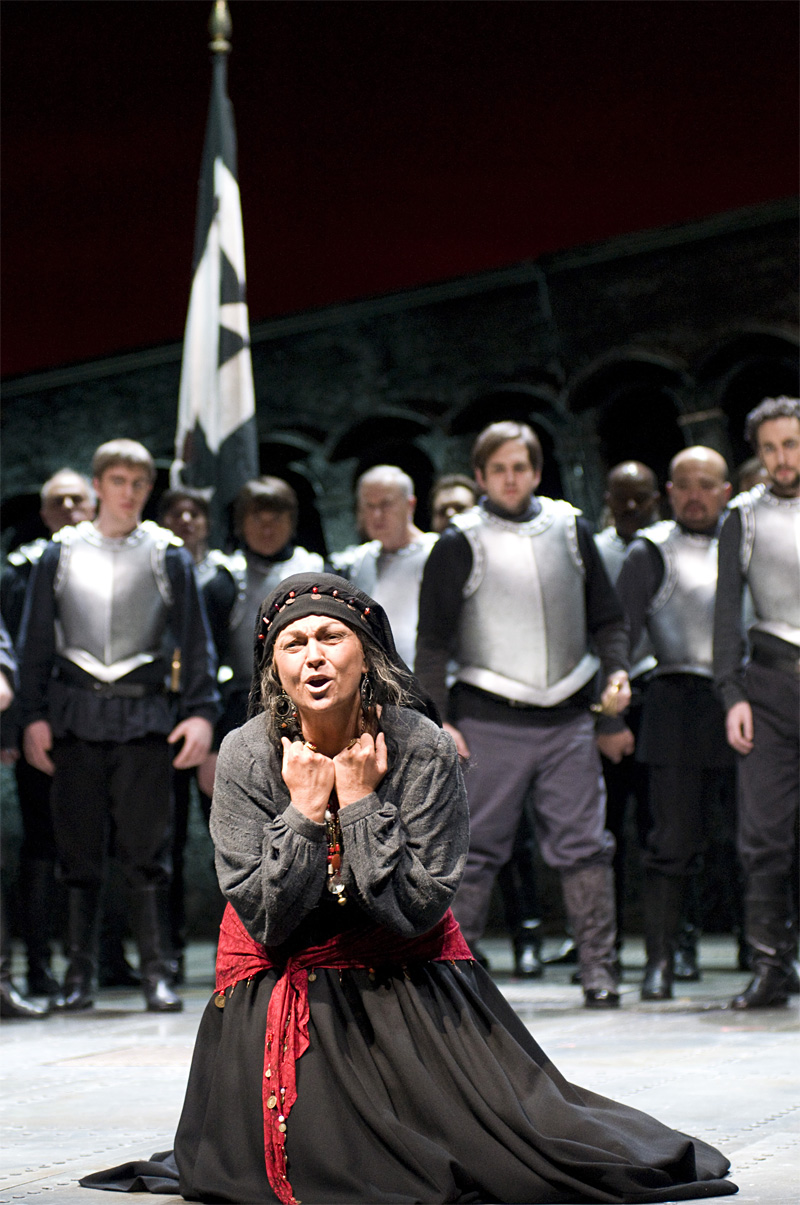The fat lady in blonde braids and a horned helmet came from Wagner, but most every other popular opera cliché can be traced to Verdi’s 1853 melodrama Il trovatore. If Verdi didn’t invent them, he exploited them here more shamelessly and effectively than anyone: the ludicrously complex plot, the none-too-bright tenor hero, the baritone villain, the soprano they spar over, the park-and-bark show-off solos, the grand ensemble where everyone just stands and sings rather than getting on with the action.
José Maria Condemi, in his production for Seattle Opera, wisely decided to heighten the unreality, taking art, it seems, as inspiration: Allen Moyer’s set places the action within a huge, cracked gold frame, with set pieces Cubistically tilted and distorted Picasso-style and costumes (by John Conklin) in velvety blacks, reds, and silvers a la Velazquez. (Spanish painters, of course, for an opera set in Spain.) A forward-reaching ramp spills the action out past the frame into our laps, a painting come to life; for once, the pejorative “museum piece” is turned from a weakness to a strength.
Aside from a few utilitarian minor roles, this opera is all about the four leads (Caruso quipped that all Trovatore requires is the four greatest singers in the world). At Saturday night’s opening, the Gold Cast member most in tune with this storybook approach was Lisa Daltirus as heroine Leonora. A noblewoman to the marrow, everything she does is straight out of Diva 101: sweeping around the stage in a ball gown, toying girlishly with a handkerchief, raising a supplicant arm skyward, clutching a fist to her bosom at moments of peak emotion. Impressively, from these stock gestures she makes a real person out of one of the most cardboard characters in the soprano repertory. Unwaveringly committed to her approach to the role, Daltirus also sings it beautifully. Her lovely, well-controlled high notes become in her hands, or throat, versatile tools—she can float them ethereally or set them ablaze. Or both, as she did memorably at the end of “D’amor sull’ali rosee” in Act 4, thinning and softening her final note before crescendoing at the very last moment, like a candle flaring brightly just before it goes out.
A thrusting, trumpetlike voice has made Antonello Palombi SO’s go-to tenor for heavier Italian roles. In Manrico’s barn-burner aria “Di quella pira” he does take, serviceably, the two high C’s which used to be optional but which now no tenor dares to disappoint the audience by omitting. As Count di Luna, Gordon Hawkins is more thuggish than suavely sinister, and he displays just a shade of wobble in his long notes. Still, the dark power of his baritone balances nicely with the voices of Palombi and Daltirus. As Manrico’s mother, Azucena, who’s as much undone by her own obsessions as by the Count’s villainy, Malgorzata Walewska makes an intensely tragic figure.
Yet even with this star power, the performance’s excitement failed to sustain itself, much less build, and that’s directly due to the awkward set changes. After intermission, especially, two long pauses separating the scenes let all the air out of the tires; nothing’s more anticlimactic, especially in a galloping melodrama like this, than making an audience sit in uncomfortable silence in the dark while things thump and rumble behind the curtain. The 2,000 of us were good sports about it, but the obvious solution, easier than rethinking the staging from scratch, would be to give us something to listen to to preserve the mood. Verdi did write ballet music for Trovatore, which is never used; filching a few bits of fluff to use as entr’actes would be better than nothing. A practical theater man, ready to do what it took to make a performance work, Verdi would have approved.







